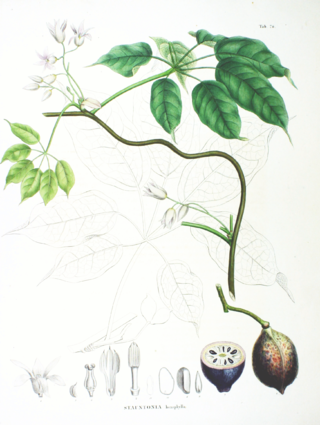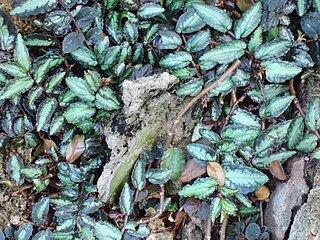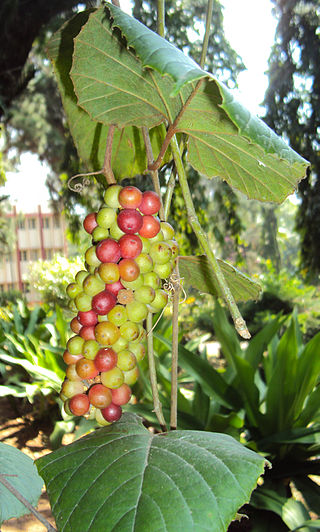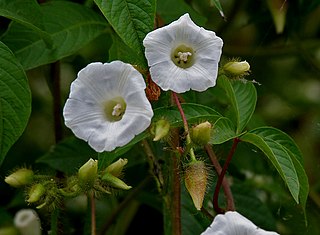
Convolvulaceae, commonly called the bindweeds or morning glories, is a family of about 60 genera and more than 1,650 species. These species are primarily herbaceous vines, but also include trees, shrubs and herbs. The tubers of several species are edible, the best known of which is the sweet potato.

Argyreia is a genus of plants in the family Convolvulaceae.

Antidesma is a genus of tropical plant in the family Phyllanthaceae formally described by Linnaeus in 1753. It is native to tropical Africa, S + E + SE Asia, Australia, and various oceanic islands. The greatest diversity occurs in Southeast Asia.

Stauntonia is a genus of flowering plants in the family Lardizabalaceae. It is named after George Staunton, who brought it to Britain from China in the 19th century.

Tetrastigma is a genus of plants in the grape family, Vitaceae. The plants are lianas that climb with tendrils and have palmately compound leaves. Plants are dioecious, with separate male and female plants; female flowers are characterized by their four-lobed stigmas. The species are found in subtropical and tropical regions of Asia, Malaysia, and Australia, where they grow in primary rainforest, gallery forest and monsoon forest and moister woodland. Species of this genus are notable as being the sole hosts of parasitic plants in the family Rafflesiaceae, one of which, Rafflesia arnoldii, produces the largest single flower in the world. Tetrastigma is the donor species for horizontal gene transfer to Sapria and Rafflesia due to multiple gene theft events.

The genus Cayratia consists of species of vine plants, typical of the tribe Cayratieae. Some of them are useful, and they are found in tropical and subtropical areas of Asia, Africa, Australia, and islands of the Pacific Ocean.

Mary Strong Clemens was an American botanist and plant collector. A fanatical botanist, she collected plants assiduously throughout her long life, in the remote parts of the Philippines, Borneo, China, New Guinea and Australia. The latter part of her life was spent in Australia, where she died in Brisbane, Queensland.

Ormosia is a genus of legumes. 131 living species, mostly trees or large shrubs, are native to the tropical Americas, from southwestern Mexico to Bolivia and southern Brazil, to southern, southeastern, and eastern Asia, and to New Guinea and Queensland. Most are tropical, while some extend into temperate temperate regions of China. A few species are threatened by habitat destruction, while the Hainan ormosia is probably extinct already.

Polyalthia is a genus of flowering plants in the family Annonaceae. There are approximately 90 species distributed from Africa to Asia and the Pacific.

Pellionia is a genus of flowering plants in the family Urticaceae. The flowers of Pellionia are white globules held on stalks above the plant, which respond to changes in temperature by releasing their pollen as little puffs of smoke.

Polyosma is a genus of about 90 species of trees native to south-east Asia. They occur from China south through south-east Asia to the east coast of Australia, New Guinea, the Solomon Islands and New Caledonia.

Ampelocissus is a genus of Vitaceae having 90 or more species found variously in tropical Africa, Asia, Central America, and Oceania. The type species, A. latifolia, was originally treated under its basionym, Vitis latifolia, and was collected from the Indian subcontinent.

Operculina is a genus of plants in the morning-glory family which that are found throughout the world.

Colona is a genus of flowering plant in the Malvaceae sensu lato or Tiliaceae: now placed in the subfamily Grewioideae. It is found in south-east Asia.

Merremia is a genus of flowering plants in the morning glory family, Convolvulaceae. Members of the genus are commonly known as woodroses.
Paul Alfred Pételot (1885–1965) was a French botanist and entomologist, whose primary scholarly focus was on medicinal plants in Southeast Asia. Some sources list his date of death as 1940, but several herbaria specimens are recorded as being collected by him up until 1944 including Carex kucyniakii (1944), Teijsmanniodendron peteloti (1941), Amalocalyx microlobus (1941), Amalocalyx microlobus (1942), Trichosanthes kerrii (1944) and Siraitia siamensis (1944). In addition, he continued to author publications through the 1950s, though it is possible these are posthumous.
Tridynamia is a genus of flowering plants belonging to the family Convolvulaceae.

Camonea is a genus of flowering plants belonging to the family Convolvulaceae.

Distimake is a genus of flowering plants belonging to the family Convolvulaceae.

Oreocnide is a genus of flowering plants belonging to the family Urticaceae.


















